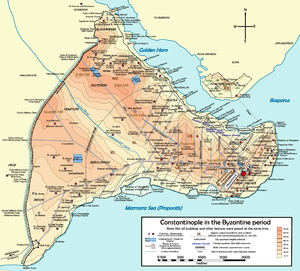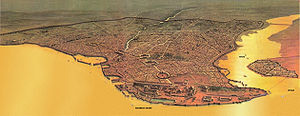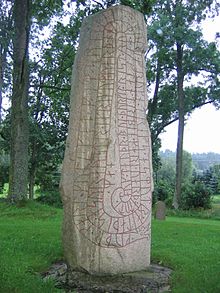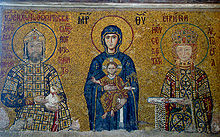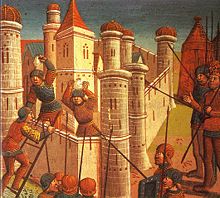- Constantinople
-
This article is about the city before the Fall of Constantinople (1453). For a more detailed approach after 1453, see History of Istanbul. For other uses, see Constantinople (disambiguation).
Constantinople (Greek: Κωνσταντινούπολις, Kōnstantinoúpolis; Latin: Nova Roma or Constantinopolis; Ottoman Turkish: قسطنطینیه, Kostantiniyye and modern Turkish: İstanbul) was the capital of the Roman, Eastern Roman, Byzantine, Latin, and Ottoman Empires. Throughout most of the Middle Ages, Constantinople was Europe's largest[1] and wealthiest city.
Contents
Names
Main article: Names of IstanbulThe city was originally founded as a Greek colony under the name of Byzantium in the 7th century BC. It took on the name of Konstantinoupolis ("city of Constantine", Constantinople) after its re-foundation under Roman emperor Constantine I, who designated it as his new Roman capital. The modern Turkish name İstanbul derives from the Greek phrase eis tin polin, meaning "in the City" or "to the City". This name was used in Turkish side by side with Kostantiniyye, the more formal Arabic–Persian adaptation of the original Constantinople, during the period of Ottoman rule, while western languages mostly continued to refer to the city as Constantinople until the early 20th century. After the creation of the Republic of Turkey in 1923, the Turkish government began to formally object to the use of Constantinople in other languages and ask that others use the more common name for the city.[2][3][4][5][6]
History
Byzantium
Main article: ByzantiumConstantinople was founded by the Roman Emperor Constantine I on the site of an already-existing city, Byzantium, settled in the early days of Greek colonial expansion, probably around 671-662 BC. The site lay astride the land route from Europe to Asia and the seaway from the Black Sea to the Mediterranean, and had in the Golden Horn an excellent and spacious harbour.
306–337
 Emperor Constantine I presents a representation of the city of Constantinople as tribute to an enthroned Mary and Christ Child in this church mosaic. St Sophia, c. 1000
Emperor Constantine I presents a representation of the city of Constantinople as tribute to an enthroned Mary and Christ Child in this church mosaic. St Sophia, c. 1000
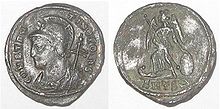 Coin struck by Constantine I to commemorate the founding of Constantinople
Coin struck by Constantine I to commemorate the founding of Constantinople
Constantine had altogether more colorful plans. Having restored the unity of the Empire, and, being in course of major governmental reforms as well as of sponsoring the consolidation of the Christian church, he was well aware that Rome was an unsatisfactory capital. Rome was too far from the frontiers, and hence from the armies and the Imperial courts, and it offered an undesirable playground for disaffected politicians. Yet it had been the capital of the state for over a thousand years, and it might have seemed unthinkable to suggest that the capital be moved to a different location. Nevertheless, he identified the site of Byzantium as the right place: a place where an emperor could sit, readily defended, with easy access to the Danube or the Euphrates frontiers, his court supplied from the rich gardens and sophisticated workshops of Roman Asia, his treasuries filled by the wealthiest provinces of the Empire.
Constantinople was built over six years, and consecrated on 11 May 330.[7] Constantine divided the expanded city, like Rome, into 14 regions, and ornamented it with public works worthy of an imperial metropolis.[8] Yet, at first, Constantine's new Rome did not have all the dignities of old Rome. It possessed a proconsul, rather than an urban prefect. It had no praetors, tribunes, or quaestors. Although it did have senators, they held the title clarus, not clarissimus, like those of Rome. It also lacked the panoply of other administrative offices regulating the food supply, police, statues, temples, sewers, aqueducts, or other public works. The new programme of building was carried out in great haste: Columns, marbles, doors, and tiles were taken wholesale from the temples of the Empire and moved to the new city. In similar fashion, many of the greatest works of Greek and Roman art were soon to be seen in its squares and streets. The Emperor stimulated private building by promising householders gifts of land from the Imperial estates in Asiana and Pontica, and on 18 May 332 he announced that, as in Rome, free distributions of food would be made to the citizens. At the time the amount is said to have been 80,000 rations a day, doled out from 117 distribution points around the city.[9]
Constantine laid out a new square at the centre of old Byzantium, naming it the Augustaeum. The new senate-house (or Curia) was housed in a basilica on the east side. On the south side of the great square was erected the Great Palace of the Emperor with its imposing entrance, the Chalke, and its ceremonial suite known as the Palace of Daphne. Nearby was the vast Hippodrome for chariot-races, seating over 80,000 spectators, and the famed Baths of Zeuxippus. At the western entrance to the Augustaeum was the Milion, a vaulted monument from which distances were measured across the Eastern Roman Empire.
From the Augustaeum led a great street, the Mese (Greek: Μέση [Οδός] lit. "Middle [Street]"), lined with colonnades. As it descended the First Hill of the city and climbed the Second Hill, it passed on the left the Praetorium or law-court. Then it passed through the oval Forum of Constantine where there was a second Senate-house and a high column with a statue of Constantine himself in the guise of Helios, crowned with a halo of seven rays and looking toward the rising sun. From there the Mese passed on and through the Forum of Taurus and then the Forum of Bous, and finally up the Seventh Hill (or Xerolophus) and through to the Golden Gate in the Constantinian Wall. After the construction of the Theodosian Walls in the early 5th century, it would be extended to the new Golden Gate, reaching a total length of seven Roman miles.[10]
395–527
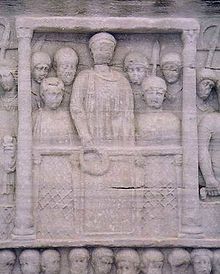 Theodosius I was the last Roman emperor who ruled over an undivided empire (detail from the Obelisk at the Hippodrome of Constantinople
Theodosius I was the last Roman emperor who ruled over an undivided empire (detail from the Obelisk at the Hippodrome of Constantinople
The first known Prefect of the City of Constantinople was Honoratus, who took office on 11 December 359 and held it until 361. The emperor Valens built the Palace of Hebdomon on the shore of the Propontis near the Golden Gate, probably for use when reviewing troops. All the emperors up to Zeno and Basiliscus were crowned and acclaimed at the Hebdomon. Theodosius I founded the Church of John the Baptist to house the skull of the saint (today preserved at the Topkapı Palace in Istanbul, Turkey), put up a memorial pillar to himself in the Forum of Taurus, and turned the ruined temple of Aphrodite into a coach house for the Praetorian Prefect; Arcadius built a new forum named after himself on the Mese, near the walls of Constantine.
The importance of Constantinople gradually increased. After the shock of the Battle of Adrianople in 378, in which the emperor Valens with the flower of the Roman armies was destroyed by the Visigoths within a few days' march, the city looked to its defenses, and Theodosius II built in 413–414 the 18-meter (60-foot)-tall triple-wall fortifications, which were never to be breached until the coming of gunpowder. Theodosius also founded a University near the Forum of Taurus, on 27 February 425.
Uldin, a prince of the Huns, appeared on the Danube about this time and advanced into Thrace, but he was deserted by many of his followers, who joined with the Romans in driving their king back north of the river. Subsequent to this, new walls were built to defend the city, and the fleet on the Danube improved.
In due course, the barbarians overran the Western Roman Empire: Its emperors retreated to Ravenna, and it diminished to nothing. Thereafter, Constantinople became in truth the largest city of the Roman Empire and of the world. Emperors were no longer peripatetic between various court capitals and palaces. They remained in their palace in the Great City, and sent generals to command their armies. The wealth of the eastern Mediterranean and western Asia flowed into Constantinople.
527–565
 Map of Constantinople (1422) by Florentine cartographer Cristoforo Buondelmonti[11] is the oldest surviving map of the city, and the only one that predates the Turkish conquest of the city in 1453
Map of Constantinople (1422) by Florentine cartographer Cristoforo Buondelmonti[11] is the oldest surviving map of the city, and the only one that predates the Turkish conquest of the city in 1453
The emperor Justinian I (527–565) was known for his successes in war, for his legal reforms and for his public works. It was from Constantinople that his expedition for the reconquest of the former Diocese of Africa set sail on or about 21 June 533. Before their departure the ship of the commander Belisarius anchored in front of the Imperial palace, and the Patriarch offered prayers for the success of the enterprise. After the victory, in 534, the Temple treasure of Jerusalem, looted by the Romans in 70 AD and taken to Carthage by the Vandals after their sack of Rome in 455, was brought to Constantinople and deposited for a time, perhaps in the Church of St. Polyeuctus, before being returned to Jerusalem in either the Church of the Resurrection or the New Church.[12]
Chariot-racing had been important in Rome for centuries. In Constantinople, the hippodrome became over time increasingly a place of political significance. It was where (as a shadow of the popular elections of old Rome) the people by acclamation showed their approval of a new emperor, and also where they openly criticized the government, or clamoured for the removal of unpopular ministers. In the time of Justinian, public order in Constantinople became a critical political issue.
Throughout the late Roman and early Byzantine periods, Christianity was resolving fundamental questions of identity, and the dispute between the orthodox and the monophysites became the cause of serious disorder, expressed through allegiance to the horse-racing parties of the Blues and the Greens. The partisans of the Blues and the Greens were said[13] to affect untrimmed facial hair, head hair shaved at the front and grown long at the back, and wide-sleeved tunics tight at the wrist; and to form gangs to engage in night-time muggings and street violence. At last these disorders took the form of a major rebellion of 532, known as the "Nika" riots (from the battle-cry of "Victory!" of those involved).
Fires started by the Nika rioters consumed Constantine's basilica of St Sophia, the city's principal church, which lay to the north of the Augustaeum. Justinian commissioned Anthemius of Tralles and Isidore of Miletus to replace it with a new and incomparable St Sophia. This was the great cathedral of the Orthodox Church, whose dome was said to be held aloft by God alone, and which was directly connected to the palace so that the imperial family could attend services without passing through the streets.[14] The dedication took place on 26 December 537 in the presence of the emperor, who exclaimed, "O Solomon, I have outdone thee!"[15] St Sophia was served by 600 people including 80 priests, and cost 20,000 pounds of gold to build.[16]
Justinian also had Anthemius and Isidore demolish and replace the original Church of the Holy Apostles built by Constantine with a new church under the same dedication. This was designed in the form of an equal-armed cross with five domes, and ornamented with beautiful mosaics. This church was to remain the burial place of the Emperors from Constantine himself until the 11th century. When the city fell to the Turks in 1453, the church was demolished to make room for the tomb of Mehmet II the Conqueror. Justinian was also concerned with other aspects of the city's built environment, legislating against the abuse of laws prohibiting building within 100 feet (30 m) of the sea front, in order to protect the view.[17]
During Justinian I's reign, the city's population reached about 500,000 people.[18] However, the social fabric of Constantinople was also damaged by the onset of Plague of Justinian between 541–542 AD. It killed perhaps 40% of the city's inhabitants.[19]
Survival, 565–717
In the early 7th century the Avars and later the Bulgars overwhelmed much of the Balkans, threatening Constantinople from the west. Simultaneously, the Persian Sassanids overwhelmed the Prefecture of the East and penetrated deep into Anatolia. Heraclius, son to the exarch of Africa, set sail for the city and assumed the purple. He found the military situation so dire that he is said at first to have contemplated withdrawing the imperial capital to Carthage, but relented after the people of Constantinople begged him to stay. Constantinople lost its right to free grain in 618, when Heraclius realized that the city no longer could be supplied from Egyptian sources due to the Persian wars. The population of Constantinople dropped substantially in size as a result, from 500,000 inhabitants to just 40,000-70,000.[20]
While the Great City withstood a siege, Heraclius campaigned deep into Persian territory and briefly restored the status quo in 628 as the Persians surrendered all their conquests. However, the empire was left weakened in the face of subsequent attacks from the Arabs when the African and south-east Mediterranean provinces were lost for good. During these wars, a first siege of Constantinople by the Muslims lasted from 674 to 678, and a second from 717 to 718. While the Theodosian Walls made the city impregnable from the land, a newly discovered incendiary substance known as "Greek Fire" allowed the Byzantine navy to destroy the Arab fleets and keep the city supplied. In the second siege, decisive help was rendered by the Bulgars. The failure of this siege was a severe blow to the Umayyad Caliphate, and stabilised the Byzantine-Arab equilibrium.
717–1025
The Högby Runestone is one of the c. 30 Greece Runestones in Sweden that commemorate members of the Varangian Guard.
In the 730s Leo III carried out extensive repairs of the Theodosian walls, which had been damaged by frequent and violent attacks; this work was financed by a special tax on all the subjects of the Empire.[21]
Theodora, widow of the Emperor Theophilus (d. 842), acted as regent during the minority of her son Michael III, who was said to have been introduced to dissolute habits by her brother Bardas. When Michael assumed power in 856, he became known for excessive drunkenness, appeared in the hippodrome as a charioteer and burlesqued the religious processions of the clergy. He removed Theodora from the Great Palace to the Carian Palace and later to the monastery of Gastria, but, after the death of Bardas, she was released to live in the palace of St Mamas; she also had a rural residence at the Anthemian Palace, where Michael was assassinated in 867.[22]
In 860, an attack was made on the city by a new principality set up a few years earlier at Kiev by Askold and Dir, two Varangian chiefs: Two hundred small vessels passed through the Bosporus and plundered the monasteries and other properties on the suburban Prince's Islands. Oryphas, the admiral of the Byzantine fleet, alerted the emperor Michael, who promptly put the invaders to flight; but the suddenness and savagery of the onslaught made a deep impression on the citizens.[23]
In 980, the emperor Basil II received an unusual gift from Prince Vladimir of Kiev: 6,000 Varangian warriors, which Basil formed into a new bodyguard known as the Varangian Guard. They were known for their ferocity, honour, and loyalty. It is said that, in 1038, they were dispersed in winter quarters in the Thracesian theme when one of their number attempted to violate a countrywoman, but in the struggle she seized his sword and killed him; instead of taking revenge, however, his comrades applauded her conduct, compensated her with all his possessions, and exposed his body without burial as if he had committed suicide.[24] However, following the death of an Emperor, they became known also for plunder in the Imperial palaces.[25] Later in the 11th Century the Varangian Guard became dominated by Anglo-Saxons who preferred this way of life to subjugation by the new Norman kings of England.[26]
The Book of the Eparch, which dates to the 10th century, gives a detailed picture of the city's commercial life and its organization at that time. The corporations in which the tradesmen of Constantinople were organised were supervised by the Eparch, who regulated such matters as production, prices, import, and export. Each guild had its own monopoly, and tradesmen might not belong to more than one. It is an impressive testament to the strength of tradition how little these arrangements had changed since the office, then known by the Latin version of its title, had been set up in 330 to mirror the urban prefecture of Rome.[27]
In the 9th and 10th centuries, Constantinople had a population of between 500,000 and 800,000.[28]
Iconoclast controversy
In the 8th and 9th centuries, the iconoclast movement caused serious political unrest throughout the Empire. The emperor Leo III issued a decree in 726 against images, and ordered the destruction of a statue of Christ over one of the doors of the Chalke, an act that was fiercely resisted by the citizens.[29] Constantine V convoked a church council in 754, which condemned the worship of images, after which many treasures were broken, burned, or painted over with depictions of trees, birds or animals: One source refers to the church of the Holy Virgin at Blachernae as having been transformed into a "fruit store and aviary".[30] Following the death of his son Leo IV in 780, the empress Irene restored the veneration of images through the agency of the Second Council of Nicaea in 787.
The iconoclast controversy returned in the early 9th century, only to be resolved once more in 843 during the regency of Empress Theodora, who restored the icons. These controversies contributed to the deterioration of relations between the Western and the Eastern Churches.
Prelude to the Comnenian period, 1025–1081
In the late 11th century catastrophe struck with the unexpected and calamitous defeat of the imperial armies at the Battle of Manzikert in Armenia in 1071. The Emperor Romanus Diogenes was captured. The peace terms demanded by Alp Arslan, sultan of the Seljuk Turks, were not excessive, and Romanus accepted them. On his release, however, Romanus found that enemies had placed their own candidate on the throne in his absence; he surrendered to them and suffered death by torture, and the new ruler, Michael VII Ducas, refused to honour the treaty. In response, the Turks began to move into Anatolia in 1073. The collapse of the old defensive system meant that they met no opposition, and the empire's resources were distracted and squandered in a series of civil wars. Thousands of Turkoman tribesmen crossed the unguarded frontier and moved into Anatolia. By 1080, a huge area had been lost to the Empire, and the Turks were within striking distance of Constantinople.
1081–1185
12th century mosaic from the upper gallery of the Hagia Sophia, Constantinople. Emperor John II (1118–1143) is shown on the left, with the Virgin Mary and infant Jesus in the centre, and John's consort Empress Irene on the right.
Under the Comnenian dynasty (1081–1185), Byzantium staged a remarkable military, financial and territorial recovery. In what is sometimes called the Comnenian Restoration, with the establishment of a new military system, the Empire recovered nearly half of the lost Anatolian lands. In 1090–91, the nomadic Pechenegs reached the walls of Constantinople, where Emperor Alexius I with the aid of the Kipchaks annihilated their army.[31] The battle of Levounion in 1091 marked the beginning of a resurgence of Byzantine power and influence that would last for a hundred years. In response to a call for aid from Alexius I Comnenus, the First Crusade assembled at Constantinople in 1096, but declining to put itself under Byzantine command set out for Jerusalem on its own account.[32] John II built the monastery of the Pantocrator (Almighty) with a hospital for the poor of 50 beds.[33]
With the restoration of firm central government, the empire became fabulously wealthy. The population was rising (estimates for Constantinople in the 12th century vary from approximately 100,000 to 500,000), and towns and cities across the realm flourished. Meanwhile, the volume of money in circulation dramatically increased. This was reflected in Constantinople by the construction of the Blachernae palace, the creation of brilliant new works of art, and general prosperity at this time: an increase in trade, made possible by the growth of the Italian city-states, may have helped the growth of the economy. It is certain that the Venetians and others were active traders in Constantinople, making a living out of shipping goods between the Crusader Kingdoms of Outremer and the West, while also trading extensively with Byzantium and Egypt. The Venetians had factories on the north side of the Golden Horn, and large numbers of westerners were present in the city throughout the 12th century. Toward the end of Manuel I's reign, the number of foreigners in the city reached about 60,000-80,000 people out of a total population of about 400,000 people.[34] In 1171, Constantinople also contained a small community of 2,500 Jews.[35]
In artistic terms, the 12th century was a very productive period. There was a revival in the mosaic art, for example: Mosaics became more realistic and vivid, with an increased emphasis on depicting three-dimensional forms. There was an increased demand for art, with more people having access to the necessary wealth to commission and pay for such work. According to N.H. Baynes (Byzantium, An Introduction to East Roman Civilization):
- "With its love of luxury and passion for colour, the art of this age delighted in the production of masterpieces that spread the fame of Byzantium throughout the whole of the Christian world. Beautiful silks from the work-shops of Constantinople also portrayed in dazzling colour animals - lions, elephants, eagles, and griffins - confronting each other, or represented Emperors gorgeously arrayed on horseback or engaged in the chase."
- "From the tenth to the twelfth century Byzantium was the main source of inspiration for the West. By their style, arrangement, and iconography the mosaics of St. Mark's at Venice and of the cathedral at Torcello clearly reveal their Byzantine origin. Similarly those of the Palatine Chapel, the Martorana at Palermo, and the cathedral of Cefalù, together with the vast decoration of the cathedral at Monreale, demonstrate the influence of Byzantium on the Norman Court of Sicily in the twelfth century. Hispano-Moorish art was unquestionably derived from the Byzantine. Romanesque art owes much to the East, from which it borrowed not only its decorative forms but the plan of some of its buildings, as is proved, for instance, by the domed churches of south-western France. Princes of Kiev, Venetian doges, abbots of Monte Cassino, merchants of Amalfi, and the kings of Sicily all looked to Byzantium for artists or works of art. Such was the influence of Byzantine art in the twelfth century, that Russia, Venice, southern Italy and Sicily all virtually became provincial centres dedicated to its production."
1185–1261
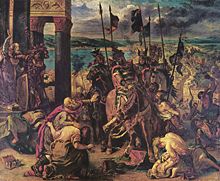 The Entry of the Crusaders into Constantinople, by Eugène Delacroix, 1840.
The Entry of the Crusaders into Constantinople, by Eugène Delacroix, 1840.
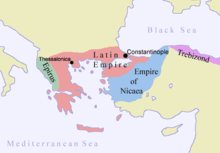 The Latin Empire, Empire of Nicaea, Empire of Trebizond, and the Despotate of Epirus. The borders are very uncertain
The Latin Empire, Empire of Nicaea, Empire of Trebizond, and the Despotate of Epirus. The borders are very uncertain
In the course of a plot between Philip of Swabia, Boniface of Montferrat and the Doge of Venice, the Fourth Crusade was, despite papal excommunication, diverted in 1203 against Constantinople, ostensibly promoting the claims of Alexius son of the deposed emperor Isaac. The reigning emperor Alexius III had made no preparation. The Crusaders occupied Galata, broke the chain protecting the Golden Horn and entered the harbour, where on 27 July they breached the sea walls: Alexius III fled. But the new Alexius IV found the Treasury inadequate, and was unable to make good the rewards he had promised to his western allies. Tension between the citizens and the Latin soldiers increased. In January 1204, the protovestiarius Alexius Murzuphlus provoked a riot, it is presumed, to intimidate Alexius IV, but whose only result was the destruction of the great statue of Athena, the work of Phidias, which stood in the principal forum facing west.
In February, the people rose again: Alexius IV was imprisoned and executed, and Murzuphlus took the purple as Alexius V. He made some attempt to repair the walls and organise the citizenry, but there had been no opportunity to bring in troops from the provinces and the guards were demoralised by the revolution. An attack by the Crusaders on 6 April failed, but a second from the Golden Horn on 12 April succeeded, and the invaders poured in. Alexius V fled. The Senate met in St Sophia and offered the crown to Theodore Lascaris, who had married into the Angelid family, but it was too late. He came out with the Patriarch to the Golden Milestone before the Great Palace and addressed the Varangian Guard. Then the two of them slipped away with many of the nobility and embarked for Asia. By the next day the Doge and the leading Franks were installed in the Great Palace, and the city was given over to pillage for three days.
The great historian of the Crusades, Sir Steven Runciman, wrote that the sack of Constantinople is “unparalleled in history”.
“For nine centuries,” he goes on, “the great city had been the capital of Christian civilisation. It was filled with works of art that had survived from ancient Greece and with the masterpieces of its own exquisite craftsmen. The Venetians, wherever they could, seized treasures and carried them off. But the Frenchmen and Flemings were filled with a lust for destruction: They rushed in a howling mob down the streets and through the houses, snatching up everything that glittered and destroying whatever they could not carry, pausing only to murder or to rape, or to break open the wine-cellars. Neither monasteries nor churches nor libraries were spared. In St Sophia itself, drunken soldiers could be seen tearing down the silken hangings and pulling the silver iconostasis to pieces, while sacred books and icons were trampled under foot. While they drank from the altar-vessels, a prostitute sang a ribald French song on the Patriarch’s throne. Nuns were ravished in their convents. Palaces and hovels alike were wrecked. Wounded women and children lay dying in the streets. For three days the ghastly scenes continued until the huge and beautiful city was a shambles. Even after order was restored, citizens were tortured to make them reveal treasures they had hidden.—[36]For the next half-century, Constantinople was the seat of the Latin Empire. The Byzantine nobility were scattered. Many went to Nicaea, where Theodore Lascaris set up an imperial court, or to Epirus, where Theodore Angelus did the same; others fled to Trebizond, where one of the Comneni had already with Georgian support established an independent seat of empire.[37] Nicaea and Epirus both vied for the imperial title, and tried to recover Constantinople. In 1261, Constantinople was captured from its last Latin ruler, Baldwin II, by the forces of the Nicaean emperor Michael VIII Palaeologus.
1261–1453
See also: Fall of ConstantinopleAlthough Constantinople was retaken by Michael VIII, the Empire had lost many of its key economic resources, and struggled to survive. The palace of Blachernae in the north-west of the city became the main Imperial residence, with the old Great Palace on the shores of the Bosporus going into decline. When Michael VIII captured the city, its population was 35,000 people, but, by the end of his reign, he had succeeded in increasing the population to about 70,000 people.[38] The Emperor achieved this by summoning former residents having fled the city when the Crusaders captured it, and by relocating Greeks from the recently reconquered Peloponnese to the capital.[39] In 1347, the Black Death spread to Constantinople.[40] In 1453, when the Ottoman Turks captured the city, it contained approximately 50,000 people.[41]
Importance
 Eagle and Snake, 6th century mosaic flooring Constantinople, Grand Imperial Palace.
Eagle and Snake, 6th century mosaic flooring Constantinople, Grand Imperial Palace.
Culture
Constantinople was the largest and richest urban center in the Eastern Mediterranean Sea during the late Eastern Roman Empire, mostly as a result of its strategic position commanding the trade routes between the Aegean Sea and the Black Sea. It would remain the capital of the eastern, Greek-speaking empire for over a thousand years. At its peak, roughly corresponding to the Middle Ages, it was the richest and largest European city, exerting a powerful cultural pull and dominating economic life in the Mediterranean. Visitors and merchants were especially struck by the beautiful monasteries and churches of the city, in particular, Hagia Sophia, or the Church of Holy Wisdom: A Russian 14th-century traveler, Stephen of Novgorod, wrote, "As for St Sophia, the human mind can neither tell it nor make description of it."
It was especially important for preserving in its libraries manuscripts of Greek and Latin authors throughout a period when instability and disorder caused their mass-destruction in western Europe and north Africa: On the city's fall, thousands of these were brought by refugees to Italy, and played a key part in stimulating the Renaissance, and the transition to the modern world. The cumulative influence of the city on the west, over the many centuries of its existence, is incalculable. In terms of technology, art and culture, as well as sheer size, Constantinople was without parallel anywhere in Europe for a thousand years.
International Status
The city provided a defence for the eastern provinces of the old Roman Empire against the barbarian invasions of the 5th century. The 18-meter-tall walls built by Theodosius II were, in essence, impregnable to the barbarians coming from south of the Danube river, who found easier targets to the west rather than the richer provinces to the east in Asia. From the 5th century, the city was also protected by the Anastasian Wall, a 60-kilometer chain of walls across the Thracian peninsula. Many scholars[who?] argue that these sophisticated fortifications allowed the east to develop relatively unmolested while Ancient Rome and the west collapsed. With the emergence of Christianity and the rise of Islam, Constantinople became the gates of Christian Europe standing at the fore of Islamic expansion. As the Byzantine Empire was situated in-between the Islamic world and the Christian west, so did Constantinople act as Europe’s first line-of-defence against Arab advances in the 7th and 8th centuries. The city, and the Empire, would ultimately fall to the Ottomans by 1453, but its enduring legacy had provided Europe centuries of resurgence following the collapse of Rome.
Architecture
Main article: Byzantine architecture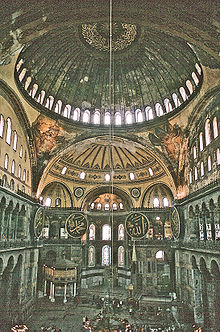 Interior view of the Hagia Sophia museum.
Interior view of the Hagia Sophia museum.
The Byzantine Empire used Roman and Greek architectural models and styles to create its own unique type of architecture. The influence of Byzantine architecture and art can be seen in the copies taken from it throughout Europe. Particular examples include St Mark's Basilica in Venice, the basilicas of Ravenna, and many churches throughout the Slavic East. Also, alone in Europe until the 13th century Italian florin, the Empire continued to produce sound gold coinage, the solidus of Diocletian becoming the bezant prized throughout the Middle Ages. Its city walls were much imitated (for example, see Caernarfon Castle) and its urban infrastructure was moreover a marvel throughout the Middle Ages, keeping alive the art, skill and technical expertise of the Roman Empire.
Religious
Constantine's foundation gave prestige to the Bishop of Constantinople, who eventually came to be known as the Ecumenical Patriarch, vying for honour with the Pope,[42] a situation that contributed to the Great Schism that divided Western Catholicism from Eastern Orthodoxy from 1054 onwards. Constantinople is also of great religious importance to Islam, as the conquest of Constantinople is one of the signs of the End time in Islam.
Popularity
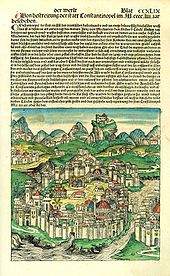 Page depicting Constantinople in the Nuremberg Chronicle published in 1493, forty years after the city's fall to the Turks
Page depicting Constantinople in the Nuremberg Chronicle published in 1493, forty years after the city's fall to the Turks
- Constantinople appears as a city of wondrous majesty, beauty, remoteness, and nostalgia in William Butler Yeats' 1928 poem "Sailing to Byzantium".
- Constantinople, as seen under the Byzantine emperor Theodosius II, makes several on-screen appearances in the television miniseries "Attila" as the capital of the Eastern Roman Empire.
- Robert Graves, author of I, Claudius, also wrote Count Belisarius, a historical novel about Belisarius. Graves set much of the novel in the Constantinople of Justinian I.
- Constantinople provides the setting of much of the action in Umberto Eco's 2000 novel Baudolino.
- Constantinople's change of name was the theme for a song made famous by The Four Lads and later covered by They Might Be Giants and many others entitled "Istanbul (Not Constantinople)".
- "Constantinople" was also the title of the opening track of The Residents' EP Duck Stab!, released in 1978.
- Constantinople under Justinian is the scene of the book "A Flame in Byzantium" (ISBN 0312930267) by Chelsea Quinn Yarbro, released in 1987.
- "Constantinople" is the title of a song by The Decemberists.
- Stephen Lawhead's novel Byzantium (1996) is set in 9th-century Constantinople.
- Filmmaker Peter Jackson said he wanted images of Minas Tirith in his The Lord of the Rings trilogy to look like "Constantinople in the morning".[cite this quote]
- Folk Metal band Turisas makes multiple references to Constantinople in their song "Miklagard Overture", referring to it as "Konstantinopolis", "Tsargrad", and "Miklagard".
- Constantinople makes an appearance in the MMORPG game Silkroad as a major capital, along with a major Chinese capital.
- Constantinople makes an appearance in the "Rome Total War" expansion "Barbarian Invasion" belonging to the Eastern Roman Empire
- Constantinople makes an appearance in the game "Age of Empires II: The Age of Kings" in the fifth scenario of the Barbarossa campaign and again in the third scenario of the Attila the Hun campaign in the expansion pack "Age of Empires II: The Conquerors Expansion".
- Constantinople will be the main setting of the game "Assassin's Creed: Revelations", a fourth major title in the best-selling "Assassin's Creed" series.[43]
See also
People from Constantinople
Secular buildings and monuments
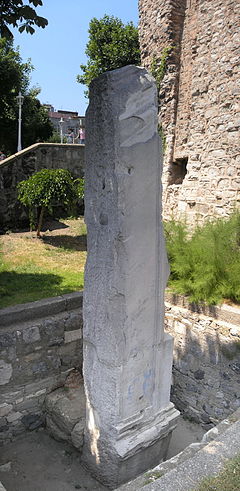 A fragment of the Milion (Greek: Μίλ(λ)ιον), a mile-marker monument
A fragment of the Milion (Greek: Μίλ(λ)ιον), a mile-marker monument
- Augustaion
- Basilica Cistern
- Baths of Zeuxippus
- Column of Marcian
- Forum of Constantine
- Great Palace of Constantinople
- Bucoleon Palace
- Hippodrome of Constantinople
- Milion
- Palace of Lausus
- Palace of Blachernae
- Valens Aqueduct
- Walls of Constantinople
Churches, monasteries and mosques
- Atik Mustafa Pasha Mosque
- Bodrum Mosque
- Chora Church
- Church of Saints Sergius and Bacchus
- Church of St. Polyeuctus
- Church of the Holy Apostles
- Eski Imaret Mosque
- Fenari Isa Mosque
- Gül Mosque
- Hagia Irene
- Hagia Sophia
- Hirami Ahmet Pasha Mosque
- Kalenderhane Mosque
- Koca Mustafa Pasha Mosque
- Nea Ekklesia
- Pammakaristos Church
- Stoudios Monastery
- Vefa Kilise Mosque
- Zeyrek Mosque
Miscellaneous
 The Entry of Mehmet II into Constantinople, by Jean-Joseph Benjamin-Constant
The Entry of Mehmet II into Constantinople, by Jean-Joseph Benjamin-Constant
- Ahmed Bican Yazıcıoğlu
- Byzantine calendar
- Byzantine silk
- Byzantium
- Ecumenical Patriarch of Constantinople
- Eparch of Constantinople (List of eparchs)
- Fall of Constantinople
- Golden Horn
- Istanbul
- List of people from Constantinople
- Massacre of the Latins
- Nika riots
- Notitia urbis Constantinopolitanae
- Sieges of Constantinople
- Third Rome
- University of Constantinople
Notes
- ^ Pounds, Norman John Greville. An Historical Geography of Europe, 1500-1840, p. 124. CUP Archive, 1979. ISBN 0521223792.
- ^ Tom Burham, The Dictionary of Misinformation, Ballantine, 1977.
- ^ BBC - Timeline: Turkey.
- ^ Room, Adrian, (1993), Place Name changes 1900-1991, Metuchen, N.J., & London:The Scarecrow Press, Inc., ISBN 0-8108-2600-3 pp. 46, 86.
- ^ Britannica, Istanbul.
- ^ Lexicorient, Istanbul.
- ^ Commemorative coins that were issued during the 330s already refer to the city as Constantinopolis (see, e.g., Michael Grant, The climax of Rome (London 1968), p. 133), or "Constantine's City". According to the Reallexikon für Antike und Christentum, vol. 164 (Stuttgart 2005), column 442, there is no evidence for the tradition that Constantine officially dubbed the city "New Rome" (Nova Roma). It is possible that the Emperor called the city "Second Rome" (Greek: Δευτέρα Ῥώμη, Deutéra Rhōmē) by official decree, as reported by the 5th-century church historian Socrates of Constantinople: See Names of Constantinople.
- ^ A description can be found in the Notitia urbis Constantinopolitanae.
- ^ Socrates II.13, cited by J B Bury, History of the Later Roman Empire, p. 74.
- ^ J B Bury, History of the Later Roman Empire, p. 75. et seqq.
- ^ Liber insularum Archipelagi, Bibliothèque nationale de France, Paris.
- ^ Margaret Barker, Times Literary Supplement 4 May 2007 p. 26.
- ^ Procopius' Secret History: see P Neville-Ure, Justinian and his Age, 1951.
- ^ St Sophia was converted into a mosque after the Ottoman conquest of the city, and is now a museum.
- ^ Source for quote: Scriptores originum Constantinopolitanarum, ed T Preger I 105 (see A. A. Vasiliev, History of the Byzantine Empire, 1952, vol I p. 188).
- ^ T. Madden, Crusades: The Illustrated History, 114.
- ^ Justinian, Novellae 63 and 165.
- ^ Early Medieval and Byzantine Civilization: Constantine to Crusades, Dr. Kenneth W. Harl.
- ^ Past pandemics that ravaged Europe, BBC News, November 7, 2005.
- ^ The Inheritance of Rome, Chris Wickham, Penguin Books Ltd. 2009, ISBN 978-0-670-02098-0 (page 260)
- ^ Vasiliev 1952, p. 251.
- ^ George Finlay, History of the Byzantine Empire, Dent, London, 1906, pp. 156-161.
- ^ Finlay, 1906 pp. 174-5.
- ^ Finlay, 1906, p. 379.
- ^ Enoksen, Lars Magnar. (1998). Runor : historia, tydning, tolkning. Historiska Media, Falun. ISBN 91-88930-32-7 p. 135.
- ^ J M Hussey, The Byzantine World, Hutchinson, London, 1967, p. 92.
- ^ Vasiliev 1952, pp. 343-4.
- ^ Silk Road Seattle - Constantinople, Daniel C. Waugh.
- ^ The officer given the task was killed by the crowd, and in the end the image was removed rather than destroyed: It was to be restored by Irene and removed again by Leo V: Finlay 1906, p. 111.
- ^ Vasiliev 1952, p. 261.
- ^ The Pechenegs, Steven Lowe and Dmitriy V. Ryaboy.
- ^ There is an excellent source for these events: the writer and historian Anna Comnena in her work The Alexiad.
- ^ Vasiliev 1952, p. 472.
- ^ J. Phillips, The Fourth Crusade and the Sack of Constantinople, 144.
- ^ J. Phillips, The Fourth Crusade and the Sack of Constantinople, 155.
- ^ Steven Runciman, History of the Crusades, Penguin Books, Harmondsworth, 1965, vol 3, pp. 111-128.
- ^ Hussey 1967, p. 70.
- ^ T. Madden, Crusades: The Illustrated History, 113.
- ^ J. Norwich, Byzantium: The Decline and Fall, 217.
- ^ The Black Death, Channel 4 - History.
- ^ D. Nicolle, Constantinople 1453: The end of Byzantium, 32.
- ^ The Fourth Canon of the First Council of Constantinople: CCEL.org
- ^ Game Informer 218 details
References
- Bury, J. B. (1958). History of the Later Roman Empire: From the Death of Theodosius I to the Death of Justinian. Dover Publications.
- Crowley, Roger (2005). Constantinople: Their Last Great Siege, 1453. Faber and Faber. ISBN 978-0-571221851.
- Murr Nehme, Lina (2003). 1453: The Fall of Constantinople. Aleph Et Taw. ISBN 2868398162.
- Freely, John (1998). Istanbul: The Imperial City. Penguin. ISBN 9780140244618.
- Freely, John; Ahmet S. Cakmak (2004). The Byzantine Monuments of Istanbul. Cambridge University Press. ISBN 9780521772570.
- Gibbon, Edward (2005). The Decline and Fall of the Roman Empire. Phoenix Press. ISBN 9780753818817.
- Hanna-Riitta, Toivanen (2007). The Influence of Constantinople on Middle Byzantine Architecture (843-1204). A typological and morphological approach at the provincial level. Suomen kirkkohistoriallisen seuran toimituksia 202 (Publications of the Finnish Society of Church History No. 202). ISBN 9789525031416.
- Harris, Jonathan (2007). Constantinople: Capital of Byzantium. Hambledon Continuum. ISBN 978-1-84725-179-4.
- Harris, Jonathan (2003). Byzantium and the Crusades. Hambledon and London. ISBN 978-1-85285-501-7.
- Herrin, Judith (2008). Byzantium: The Surprising Life of a Medieval Empire. Princeton University Press. ISBN 978-0-69113-151-1.
- Mansel, Philip (1998). Constantinople: City of the World's Desire, 1453-1924. St. Martin's Griffin. ISBN 9780312187088.
- Phillips, Jonathan (2005). The Fourth Crusade and the Sack of Constantinople. Pimlico. ISBN 978-1-84413-080-1.
- Runciman, Steven (1990). The Fall of Constantinople, 1453. Cambridge University Press. ISBN 9781844130801.
- Treadgold, Warren (1997). A History of the Byzantine State and Society. Stanford University Press. ISBN 9780804726306.
External links
- Constantinople, from History of the Later Roman Empire, by J.B. Bury
- History of Constantinople from the "New Advent Catholic Encyclopedia."
- Monuments of Byzantium - Pantokrator Monastery of Constantinople
- Constantinoupolis on the web Select internet resources on the history and culture
- Info on the name change from the Foundation for the Advancement of Sephardic Studies and Culture
- Welcome to Constantinople, documenting the monuments of Byzantine Constantinople
- Byzantium 1200, a project aimed at creating computer reconstructions of the Byzantine monuments located in Istanbul as of the year 1200 AD.
Coordinates: 41°00′44″N 28°58′34″E / 41.01224°N 28.976018°E
Categories:
Wikimedia Foundation. 2010.

